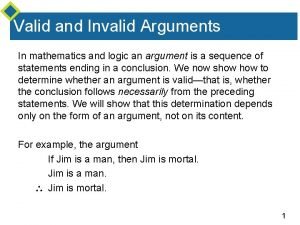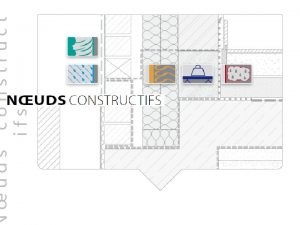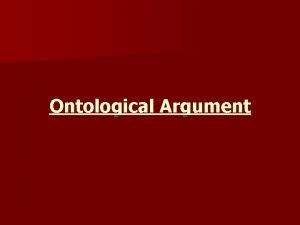SP 4 c Construct an argument that analyzes





- Slides: 5

SP 4 c Construct an argument that analyzes the production and characteristics of sounds waves February 13, 2020 Second Period, Physics

Today’s Standard: SP 4 c Construct an argument that analyzes the production and characteristics of sounds waves Name: Date: --------------; Period: ------- Bell-Ringer (Strictly 3 minutes from the bell) From Sp 4 C, which is the Standard for Today’s Learning Experience, answer the following Questions by filling in the blanks: (1) What is the verbatim of your learning task: ------------- an --------------? (2) Your ----------------- is expected to analyze which facets of the sound waves ----------------------- and ----------------------- Class Work 1 (strictly 15 minutes): Guided Practice: Read the following content (Source: https: //method-behind-the-music. com/mechanics/physics/) and answer the questions on the Production and Basic Characteristics of Sound Waves in Socrative; Room: RENUKA 1 Traveling Waves Sound is produced when something vibrates. The vibrating body causes the medium (water, air, etc. ) around it to vibrate. Vibrations in air are called traveling longitudinal waves, which we can hear. Sound waves consist of areas of high and low pressure called compressions and rarefactions, respectively. Shown in the diagram on the right is a traveling wave. The shaded bar above it represents the varying pressure of the wave. Lighter areas are low pressure (rarefactions) and darker areas are high pressure (compressions). One wavelength of the wave is highlighted in red. This pattern repeats indefinitely. The wavelength of voice is about one meter long. The wavelength and the speed of the wave determine the pitch, or frequency of the sound. Wavelength, frequency, and speed are related by the equation speed = frequency * wavelength. Since sound travels at 343 meters per second at standard temperature and pressure (STP), speed is a constant. Thus, frequency is determined by speed / wavelength. The longer the wavelength, the lower the pitch. The 'height' of the wave is its amplitude. The amplitude determines how loud a sound will be. Greater amplitude means the sound will be louder. Interference When two waves meet, there can be two kinds of interference patterns; constructive and destructive. Constructive interference is when two waveforms are added together. The peaks add with the peaks, and the troughs add with the troughs, creating a louder sound. Destructive interference occurs when two waves are out of phase (the peaks on one line up with troughs on the other). In this, the peaks cancel out the troughs, creating a diminished waveform. For example, if two waveforms that are exactly the same are added, the amplitude doubles, but when two opposite waveforms are added, they cancel out, leaving silence. Standing Waves Vibration inside a tube forms a standing wave. A standing wave is the result of the wave reflecting off the end of the tube (whether closed or open) and interfering with itself. When sound is produced in an instrument by blowing it, only the waves that will fit in the tube resonate, while other frequencies are lost. The longest wave that can fit in the tube is the fundamental, while other waves that fit are overtones. Overtones are multiples of the fundamental. The areas of highest vibration are called antinodes (labeled 'A' on the diagram), while the areas of least vibration are called nodes (labeled 'N' in the diagram). In an open pipe, the ends are antinodes. However, in a pipe closed at one end, the closed end is a node, while the blown end is an antinode. Thus, closed pipes yield only half the harmonics. Transverse Waves If a string that is fixed on both ends is bowed or plucked, such as in a violin, vibrations are formed that are in a standing wave pattern, having nodes at the fixed ends, and an antinode in the center. Several harmonics are also produced, in a similar way to the standing wave Overtones are the other frequencies besides the fundamental that exist in musical instruments. Instruments of different shapes and actions produce different overtones. The overtones combine to form the characteristic sound of the instrument. For example, both the waves on the right are of the same frequency, and therefore the same note. But their overtones are different, and therefore their sounds are different. Note that the violin's jagged waveform produces a sharper sound, while the smooth waveform of the piano produces a purer sound, closer to a sine wave. Click on each wave to hear what it sounds like. Keep in mind that all are playing the same note. Interference

Collaborative Practice (strictly 25 minutes for all the three collaborative tasks) : You can work with a partner sitting next to you to verify your answers. No movement outside of your seat is needed. The purpose of collaboration is strictly to discuss and arrive at the correct response. Not to copy the answer from the other. Collaborative Task 1: You might not think you could hear someone whispering if they sat a long way away, but if they can make the sound of their voice bounce off something into your ears, their voice will travel much further than usual. If you're inside a building with a giant dome, the sounds you make will reflect off the curved roof like light rays bouncing off a mirror. Buildings that work this way are sometimes called whispering galleries. The dome of the US Capitol and the famous reading room in the British Museum in London are two well known examples. You can hear the same effect at work outside when you sit in a naturally curved area called an amphitheater. You can talk in a normal voice and still be heard very clearly a considerable distance away. Photos: 1) The Capitol in Washington, DC has a whispering gallery inside its dome. Photo by courtesy of The Architect of the Capitol. 2) It's easy to hear people talking in this amphitheater in Iraq. Photo by Jason L. Andrade courtesy of US Marine Corps. Collaborative Task 2: Watch the video in the following link to answer the questions in Box 2 (to get this link, type “in shures crazy no echo room” in your browser, go to the first website, it is 0. 54 sec long video. https: //www. youtube. com/watch? v=w. Axmrn 6 W 7 YM 1. What is the name given to the type of chamber you observed in the video? 2. List three phenomena of sound, which are said to be absent in this chamber: (1) (2) (3) 3. What materials make the floor of the chamber? 4. Does being in the room cause any discomfort? What are such discomforts? 5. What information is our brain used to which one would no more get in this room? Collaborative Task 3: Doppler Effect Watch the video at https: //www. youtube. com/watch? v=ye. Bwzm. Mi 9 M 0 And answer the following questions. To get this link, type in your browser, “application of doppler effect tutor vista video”, go to the first website, it is a video, 3 minutes, 47 seconds long. (1) List the colors of the visible light spectrum in order of lowest to highest frequency. Photo 1: Capitol, Washington (1) Photo 2: Amphitheater, Iraq Do whispering galleries and amphitheaters have something in common in their architectural design? State the design and explain. (2) When galaxies move away from us they appear to have a “red shift” in color. Explain why this happens. (3) What color do galaxies appear if they are moving towards us? (4) What are two other real world applications of the Doppler effect? (2) Fill in the banks: In general, the speed of sound diminishes with distance, but in the whispering galleries and amphitheaters, sound travels --------than usual.

Independent Practice (1): Additional Questions on Doppler Effect (strictly 10 minutes) Constructing an argument When writing an essay it is essential to construct an argument. An argument is a particular stand (5) When an automobile moves towards a listener, the sound of its horn seems relatively on an issue or question. It is made up of a series of claims. There are two types of claim: a. Low pitched (low frequency) b. High Pitched (high frequency) • the conclusion: the final claim that you are trying to prove. This is often the answer to a direct c. Normal (no change in frequency) question, and is also known as thesis statement. (6) When the automobile moves away from the listener, its horn seems • the premises: other claims that lead to or contribute to thesis statement. These are often topic a. Low pitched (low frequency) b. High Pitched (high frequency) sentences of paragraphs. c. Normal (no change in frequency) In order to prove the premises, you must also provide: (7) The changed pitch of the Doppler effect is due to changes in • the evidence: the research, facts and discussion used to prove those points. a. Wave speed b. wave frequency Therefore, if you are asked to argue a concept you are being asked to provide evidence to support (8) True / False: If the object stays still, but the observer moves, the Doppler effect is still your premises, which in turn support your conclusion. observed. When writing an essay, for example, thesis statement will appear in your introduction and (9) True / False: A moving wave source does not affect the frequency of the wave encountered conclusion. Each premise is usually in a separate paragraph, supported by the evidence for that by the observer. premise. For more on structuring an essay, see essay planning and structure. (10) True / False: A higher frequency results when a wave source moves towards an observer. Identifying a claim (11) Two fire trucks with sirens on speed towards and away from an observer as shown below. You can often identify a premise or a conclusion by the kinds of words used: • Premise: since, because, as, for, given that, assuming that A B • Conclusion: thus, therefore, hence, so, it follows that, we may conclude that (Flage, 2003, pp. 58 -9) As Allen (2004, p. 19) observes, sometimes the same claim can be used as either a conclusion or a premise, depending on the point you want to make: "Your car is dirty [conclusion] because you drove through some mud [premise]. " "You should wash your car [conclusion] since your car is dirty [premise]. " What makes a strong argument? An argument is strong if it offers logical support for its conclusion. An argument is weak if there are gaps or bad connections between the premises which undermine their link to the conclusion. 11. 1) Which truck produces a higher than normal siren frequency? A strong argument is: 11. 2) Which truck produces a lower than normal siren frequency? • supported: the evidence is convincing and objective, and it supports the claims Independent Practice (2) & Ticket Out the Door: (Strictly 30 minutes – use Google Docs and share • balanced: the argument considers all the different perspectives, and comes to a reasonable with me): Constructing an argument, which analyzes the characteristics of sound waves); your conclusion based on those perspectives argument content for this task is given on the next page; you may choose any one of the given • logical: the argument is clearly and consistently reasoned. An argument that contains errors of statements for constructing your argument. Your response needs to include various phenomena of logic (also known as logical fallacies) is weak. waves, visuals, and cited references that support your claims and evidences in the argument. You can examine the strength of your argument by applying the principles of critical reading. References and further reading Consult the following article to have a clear understanding of What is “Constructing Argument” and Allen, M. (2004). Smart thinking: Skills for critical understanding and writing (2 nd ed. ). Melbourne, how to construct an argument Australia: Oxford University Press. [Massey Library link] Flage, D. (2003). The art of questioning: An introduction to critical thinking. Upper Saddle River, This article is available at http: //owll. massey. ac. nz/study-skills/constructing-an-argument. php NJ: Pearson Education. [Massey Library link]

Statements for Constructing Argument for Independent Practice (2) and Ticket Out the Door A (You can choose any one of the following statements for constructing your argument; be original and do not copy from other students or from resources. Beware of plagiarism) (1) Sound waves are mechanical waves (2) Sound waves are unlike light waves (3) Sound waves undergo refraction as they move from one medium to the other medium (4) Sound cannot be a part of the electromagnetic spectrum (5) The world of music is based on overtones and interference (6) The pitch of human voice obeys all laws and rules of physics of sound (7) Noise pollution results in hearing loss in humans and marine organisms (8) Absence of echo is deleterious to health









